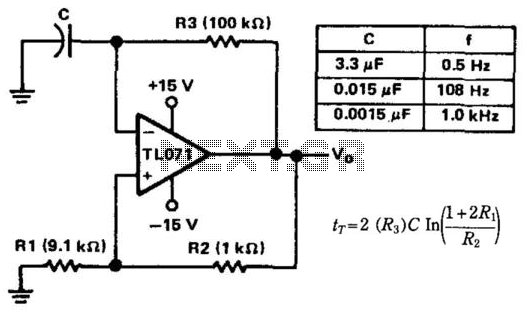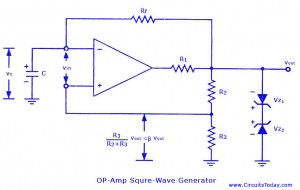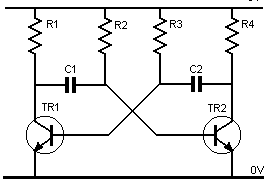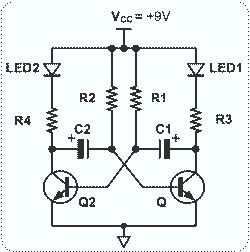
ASTABLE MULTIVIBRATOR

A multivibrator that generates its own square waves without requiring an external trigger pulse is known as an astable multivibrator. This circuit is also referred to as a free-running multivibrator. It lacks a stable state and instead oscillates continuously between two quasi-stable states. Consequently, it functions as an oscillator, necessitating DC power for operation. In this circuit, neither of the two transistors achieves a stable state; they switch back and forth between conducting (ON state) and non-conducting (OFF state) based on circuit constants. Initially, one transistor conducts while the other remains off for a specific duration. After this period, the second transistor is automatically turned on, and the first transistor is turned off, generating a square wave. The frequency and width of this square wave depend on the circuit constants.
The circuit of a collector-coupled astable multivibrator typically employs two identical NPN transistors, Q1 and Q2. In a symmetrical configuration, resistors RL1, RL2, R1, and R2, along with capacitors C1 and C2, can be equal. Transistor Q1 is forward-biased by the Vcc supply through resistor R2, while Q2 is forward-biased by Vcc through resistor R1. The output from Q1 is coupled to the input of Q2 via capacitor C2, and the output from Q2 is coupled to the input of Q1 through capacitor C1. This setup consists of two common-emitter amplifying stages, where each stage provides feedback through a capacitor to the input of the other. The amplifying stage introduces a 180-degree phase shift, while an additional 180-degree phase shift is introduced by the capacitive coupling, enabling the circuit to function as an oscillator.
Due to capacitive coupling, neither transistor can remain permanently in the off or saturated state, resulting in two quasi-stable states (ON and OFF) with periodic transitions between them. The output of the astable multivibrator can be obtained from the collector terminals of either transistor, with the two outputs being 180 degrees out of phase, making one output the complement of the other. When the DC power supply is activated, one transistor will begin conducting before the other due to inherent variations in transistor characteristics. For instance, if Q1 starts conducting before Q2, the feedback system drives Q1 rapidly into saturation while Q2 transitions to cutoff.
The operation of the circuit can be detailed as follows: when the voltage across capacitor C2 rises above 0.7V, it biases Q2 into conduction, quickly driving it to saturation. As Q2 saturates, the voltage Vcc decreases to nearly zero, causing the potential at point B to drop from Vcc to almost 0V. This negative swing is applied to the base of Q1 through C1, resulting in Q1 being pulled out of saturation and driven to cutoff. The circuit alternates between states where Q1 is ON and Q2 is OFF, and vice versa. The duration of each state is determined by the RC time constants.
The voltage waveform observed at either collector (designated as points A and B) is essentially a square waveform with a peak amplitude equal to Vcc. Achieving frequency control in a collector-coupled astable multivibrator is challenging due to limitations in varying VBB over a long range. In contrast, an emitter-coupled multivibrator offers improved frequency control capabilities.A multivibrator which generates square waves of its own (i. e without any external trigger pulse) is known as astable multivibrator. It is also called free ramming multivibrator. It has no stable state but only two quasi-stable (half-stable) makes oscillating continuously between these states. Thus it is just an oscillator since it requires no exte rnal pulse for its operation of course it does require D. C power. In such circuit neither of the two transistors reaches a stable state. It switches back and forth from one state to the other, remaining in each state for a time determined by circuit constants. In other words, at first one transistor conducts (i. e. ON state) and the other stays in the OFF state for some time. After this period of time, the second transistor is automatically turned ON and the first transistor turned OFF.
Thus the multivibrator will generate a square wave of its own. The width of the square wave and it frequency will depend upon the circuit constants. Figure (a) shows the circuit of a collector coupled astable multivibrator using two identical NPN transistors Q1 and Q2. It is possible to have RL1 = RL2 = RL = R1 = R2 = R and C1 = C2 = C. In that case, the circuit is known as symmetrical astable multivibrator. The transistor Q1 is forward biased by the Vcc supply through resistor R2. Similarly the transistor Q2 is forward biased by the Vcc supply through resistor R1. The output of transistor Q1 is coupled to the input of transistor Q2 through the capacitor C2. Similarly the output of transistor Q2 is coupled to the input of transistor Q1 through the capacitor C1.
It consists of two common emitter amplifying stages. Each stage provides a feedback through a capacitor at the input of the other. Since the amplifying stage introduces a 180o phase shift and another 180o phase shift is introduced by a capacitor, therefore the feedback signal and the circuit works as an oscillator. In other words because of capacitive coupling none of the transistor can remain permanently out-off or saturated, instead of circuit has two quasi-stable states (ON and OFF) and it makes periodic transition between these two states.
The output of an astable multivibrator is available at the collector terminal of the either transistors as shown in figure (a). However, the two outputs are 180o out of phase with each other. Therefore one of the output is said to be the complement of the other. When the D. C power supply is switched ON by closing S, one of the transistors will start conducting before the other (or slightly faster then the other).
it is so because characteristics of no two similar transistors can be exactly alike suppose that Q1 starts conducting before Q2 does. The feedback system is such that Q1 will be very rapidly driven ton saturation and Q2 to cut-off. The circuit operation may be explained as follows. When voltage across C2 rises sufficiently (i. e. more than 0. 7V), it biases Q2 in the forward direction so that it starts conducting and is soon driven to saturation.
VCC decreases and becomes almost zero when Q2 gets saturated. The potential of point B decreases from VCCto almost 0V. This potential decrease (negative swing) is applied to the base of Q1 through C1. Consequently, Q1 is pulled out of saturation and is soon driven to cut-off. It is observed that the circuit alternates between a state in which Q1 is ON and Q2 is OFF and the state in which Q1 is OFF and Q2 is ON. This time in each states depends on RC values. Since each transistor is driven alternately into saturation and cut-off. The voltage waveform at either collector (points A and B in figure (b) is essentially a square waveform with a peak amplitude equal to VCC.
(iii) to vary VBB which also can not be varied over a long range. Thus it is difficult to achieve frequency control in collector coupled astable multivibrator, not an emitter coupled multivibrator, to be described here, has a s 🔗 External reference
The circuit of a collector-coupled astable multivibrator typically employs two identical NPN transistors, Q1 and Q2. In a symmetrical configuration, resistors RL1, RL2, R1, and R2, along with capacitors C1 and C2, can be equal. Transistor Q1 is forward-biased by the Vcc supply through resistor R2, while Q2 is forward-biased by Vcc through resistor R1. The output from Q1 is coupled to the input of Q2 via capacitor C2, and the output from Q2 is coupled to the input of Q1 through capacitor C1. This setup consists of two common-emitter amplifying stages, where each stage provides feedback through a capacitor to the input of the other. The amplifying stage introduces a 180-degree phase shift, while an additional 180-degree phase shift is introduced by the capacitive coupling, enabling the circuit to function as an oscillator.
Due to capacitive coupling, neither transistor can remain permanently in the off or saturated state, resulting in two quasi-stable states (ON and OFF) with periodic transitions between them. The output of the astable multivibrator can be obtained from the collector terminals of either transistor, with the two outputs being 180 degrees out of phase, making one output the complement of the other. When the DC power supply is activated, one transistor will begin conducting before the other due to inherent variations in transistor characteristics. For instance, if Q1 starts conducting before Q2, the feedback system drives Q1 rapidly into saturation while Q2 transitions to cutoff.
The operation of the circuit can be detailed as follows: when the voltage across capacitor C2 rises above 0.7V, it biases Q2 into conduction, quickly driving it to saturation. As Q2 saturates, the voltage Vcc decreases to nearly zero, causing the potential at point B to drop from Vcc to almost 0V. This negative swing is applied to the base of Q1 through C1, resulting in Q1 being pulled out of saturation and driven to cutoff. The circuit alternates between states where Q1 is ON and Q2 is OFF, and vice versa. The duration of each state is determined by the RC time constants.
The voltage waveform observed at either collector (designated as points A and B) is essentially a square waveform with a peak amplitude equal to Vcc. Achieving frequency control in a collector-coupled astable multivibrator is challenging due to limitations in varying VBB over a long range. In contrast, an emitter-coupled multivibrator offers improved frequency control capabilities.A multivibrator which generates square waves of its own (i. e without any external trigger pulse) is known as astable multivibrator. It is also called free ramming multivibrator. It has no stable state but only two quasi-stable (half-stable) makes oscillating continuously between these states. Thus it is just an oscillator since it requires no exte rnal pulse for its operation of course it does require D. C power. In such circuit neither of the two transistors reaches a stable state. It switches back and forth from one state to the other, remaining in each state for a time determined by circuit constants. In other words, at first one transistor conducts (i. e. ON state) and the other stays in the OFF state for some time. After this period of time, the second transistor is automatically turned ON and the first transistor turned OFF.
Thus the multivibrator will generate a square wave of its own. The width of the square wave and it frequency will depend upon the circuit constants. Figure (a) shows the circuit of a collector coupled astable multivibrator using two identical NPN transistors Q1 and Q2. It is possible to have RL1 = RL2 = RL = R1 = R2 = R and C1 = C2 = C. In that case, the circuit is known as symmetrical astable multivibrator. The transistor Q1 is forward biased by the Vcc supply through resistor R2. Similarly the transistor Q2 is forward biased by the Vcc supply through resistor R1. The output of transistor Q1 is coupled to the input of transistor Q2 through the capacitor C2. Similarly the output of transistor Q2 is coupled to the input of transistor Q1 through the capacitor C1.
It consists of two common emitter amplifying stages. Each stage provides a feedback through a capacitor at the input of the other. Since the amplifying stage introduces a 180o phase shift and another 180o phase shift is introduced by a capacitor, therefore the feedback signal and the circuit works as an oscillator. In other words because of capacitive coupling none of the transistor can remain permanently out-off or saturated, instead of circuit has two quasi-stable states (ON and OFF) and it makes periodic transition between these two states.
The output of an astable multivibrator is available at the collector terminal of the either transistors as shown in figure (a). However, the two outputs are 180o out of phase with each other. Therefore one of the output is said to be the complement of the other. When the D. C power supply is switched ON by closing S, one of the transistors will start conducting before the other (or slightly faster then the other).
it is so because characteristics of no two similar transistors can be exactly alike suppose that Q1 starts conducting before Q2 does. The feedback system is such that Q1 will be very rapidly driven ton saturation and Q2 to cut-off. The circuit operation may be explained as follows. When voltage across C2 rises sufficiently (i. e. more than 0. 7V), it biases Q2 in the forward direction so that it starts conducting and is soon driven to saturation.
VCC decreases and becomes almost zero when Q2 gets saturated. The potential of point B decreases from VCCto almost 0V. This potential decrease (negative swing) is applied to the base of Q1 through C1. Consequently, Q1 is pulled out of saturation and is soon driven to cut-off. It is observed that the circuit alternates between a state in which Q1 is ON and Q2 is OFF and the state in which Q1 is OFF and Q2 is ON. This time in each states depends on RC values. Since each transistor is driven alternately into saturation and cut-off. The voltage waveform at either collector (points A and B in figure (b) is essentially a square waveform with a peak amplitude equal to VCC.
(iii) to vary VBB which also can not be varied over a long range. Thus it is difficult to achieve frequency control in collector coupled astable multivibrator, not an emitter coupled multivibrator, to be described here, has a s 🔗 External reference





